Baby Leaf Sweater |
|||||||||||||||||||
 |
 |
||||||||||||||||||
Knitted sweater for baby and kids in DROPS Alaska. Piece is knitted with raglan and cables, top down. Size 6 month - 8 years
DROPS Baby & Children 38-9 |
|||||||||||||||||||
|
------------------------------------------------------- EXPLANATION FOR THE PATTERN: ------------------------------------------------------- PATTERN: See diagrams A.1 to A.4. DECREASE TIP (applies to sleeves): Decrease 1 stitch on each side of marker as follows: Work until 3 stitches remain before marker, knit 2 together, knit 2 (marker is between these stitches), slip 1 stitch knitwise, knit 1, pass slipped stitch over stitch worked. BIND-OFF TIP: To avoid a tight bind-off edge you may use a larger needle size. If this also is too tight, work a 1 yarn over after approx. every 4th stitch while binding off (bind off yarn overs as regular stitches). ------------------------------------------------------- START THE PIECE HERE: ------------------------------------------------------- SWEATER - SHORT OVERVIEW OF THE PIECE: Worked top down. Work neck edge in the round on double pointed needles/a short circular needle. Work yoke with cables and raglan increase on circular needle. Divide piece for body and sleeves. Continue body in the round on circular needle with cables. Work sleeves in the round on double pointed needles. NECK EDGE: Cast on 52-52 (60-60-68-68) stitches on double pointed needles/circular needle size 4.5 MM = US 7 with Alaska. Knit 1 round. Round starts approx. mid back. Then work rib as follows: Half back piece: * Knit 2, purl 2 *, work from *-* over 4-4 (4-4-8-8) stitches, A.1 (= 5 stitches). Right sleeve: * Purl 2, knit 2 *, work from *-* over the next 6-6 (10-10-10-10) stitches (i.e. begin and end with purl 2). Front piece: A.2 (= 5 stitches), * purl 2, knit 2 *, work from *-* over the next 10-10 (10-10-14-14) stitches (i.e. begin and end with purl 2), A.1 over 5 stitches. Left sleeve: * Purl 2, knit 2 *, work from *-* over the next 6-6 (10-10-10-10) stitches (i.e. begin and end with purl 2). Half back piece: A.2 over 5 stitches, * purl 2, knit 2 *, over the last 6 stitches (i.e. begin and end with purl 2). Continue with knit over knit and purl over purl until piece measures 3 cm = 1⅛". Insert 1 marker at the beginning of round, measure from this marker! Switch to circular needle size 5.5 MM = US 9 and work yoke as follows: YOKE: Work next round as follows: Half back piece: Knit 3-3 (3-3-7-7) while increasing 0-1 (2-3-1-3) stitches evenly, 1 yarn over, A.3 (= 7 stitches). Right sleeve: 1 yarn over, knit 4-4 (8-8-8-8) while increasing 4-4 (0-2-2-2) stitches evenly, 1 yarn over. Front piece: A.4 (= 7 stitches), 1 yarn over, knit 8-8 (8-8-12-12) while increasing 0-2 (4-6-2-6) stitches evenly, 1 yarn over, A.3 over 7 stitches. Left sleeve: 1 yarn over, knit 4-4 (8-8-8-8) while increasing 4-4 (0-2-2-2) stitches evenly, 1 yarn over. Half back piece: A.4 over 7 stitches, 1 yarn over, knit 5 while increasing 0-1 (2-3-1-3) stitches evenly. 8-12 (8-16-8-16) stitches have been increased evenly in total, 1 yarn over on each side of A.3/A.4 (= 8 stitches increased in total for raglan) and 1 stitch in every A.3/A.4 (= 4 stitches) = 72-76 (80-88-88-96) stitches in total on row. Knit yarn overs on each side of A.3/A.4 on next round to make holes. Do work the other yarn overs twisted to avoid holes. Continue with A.3 and A.4 and stockinette stitch over the remaining stitches and increase every other round 10-11 (12-12-13-14) times in total (including the first increase explained above)= 144-156 (168-176-184-200 ) stitches. When A.3a and A.4a have been worked 1 time vertically, repeat A.3a and A.4a vertically.REMEMBER THE KNITTING GAUGE! After all increases piece measures approx. 10-11 (12-12-13-14) cm = 4"-4⅜" (4¾"-4¾"-5⅛"-5½") from marker. Then work as before without increases until piece measures 11-12 (13-14-15-16) cm = 4⅜"-4¾" (5⅛"-5½"-6"-6¼"). Now divide the piece for body and sleeves on next round as follows: Work over the first 21-23 (25-26-29-32) stitches as before, slip the next 28-30 (32-34-36-38) stitches on a stitch holder for sleeve and cast on 6 stitches under sleeve, work as before over the next 44-48 (52-54-56-62) stitches, slip the next 28-30 (32-34-36-38) stitches on a stitch holder for sleeve and cast on 6 stitches under sleeve and work the last 23-25 (27-28-27-30) stitches as before. BODY: = 100-108 (116-120-124-136) stitches. Continue in the round with stockinette stitch and A.3/A.4 as before. Work stitches cast on under sleeve in in stockinette stitch. When piece measures 13-15 (17-20-23-26) cm = 5⅛"-6" (6¾"-8"-9"-10¼") from division (approx. 3 cm = 1⅛" remain), work next round as follows: Knit 13-15 (17-18-21-24) while increasing 0-2 (4-3-4-1) stitches evenly, A.3a as before, knit 6 while increasing 2 stitches evenly, A.4a as before, knit 28-32 (36-38-40-46) while increasing 4-4 (4-6-4-6) evenly, A.3a as before, knit 6 while increasing 2 stitches evenly, A.4a as before, knit 15-17 (19-20-19-22) while increasing 4-2 (0-3-0-5) stitches evenly = 112-120 (128-136-136-152) stitches. Switch to circular needle size 4.5 MM = US 7. Then work rib as follows: * Purl 2, knit 2 *, work from *-* over the first 12-16 (20-20-24-24) stitches, purl 1, A.3b over A.3a, purl 1, * knit 2, purl 2 *, work from *-* over 6 stitches, purl 1, A.4b over A.4a, purl 1, * knit 2, purl 2 *, work from *-* over 30-34 (38-42-42-50) stitches, purl 1, A.3b over A.3a, purl 1, * knit 2, purl 2 *, work from *-* over 6 stitches, purl 1, A.4b over A.4a, purl 1, * knit 2, purl 2 *, work from *-* over 18-18 (18-22-18-26) stitches (i.e. begin and end with knit 2). Continue with knit over knit and purl over purl until piece measures 16-18 (20-23-26-29) cm = 6¼"-7" (8"-9"-10¼"-11⅜") from division. Bind off with knit over knit and purl over purl - read BIND-OFF TIP. Sweater measures approx. 30-33 (36-40-44-48) cm = 11¾"-13" (14¼"-15¾"-17¼"-19") from shoulder and down. SLEEVES: Slip the 28-30 (32-34-36-38) stitches from stitch holder in one side of piece on double pointed needles size 5.5 MM = US 9 and pick up 1 stitch in each of the 6 stitches cast on under sleeve = 34-36 (38-40-42-44) stitches. Insert 1 marker in the middle of the 6 new stitches under the sleeve. Decrease on each side of this marker later. Work in stockinette stitch in the round. When sleeve measures 3 cm = 1⅛" from division, decrease 1 stitch on each side of marker - read DECREASE TIP (= 2 stitches decreased). Decrease like this every 3-2½ (3½-5-5½-6) cm = 1⅛"-1" (1¼"-2"-2⅛"-2⅜") 3-4 (4-4-4-4) times in total = 28-28 (30-32-34-36) stitches. When piece measures 13-15 (18-22-25-29) cm = 5⅛"-6" (7"-8¾"-9¾"-11⅜") from division, increase 0-0 (2-0-2-0) stitches evenly = 28-28 (32-32-36-36) stitches. Switch to double pointed needles size 4.5 MM = US 7. Work rib (= knit 2/purl 2). Bind off with knit over knit and purl over purl when sleeve measures 16-18 (21-25-28-32) cm = 6¼"-7" (8¼"-9¾"-11"-12½") from division. Work the other sleeve the same way. |
|||||||||||||||||||
Diagram explanations |
|||||||||||||||||||
|
|||||||||||||||||||
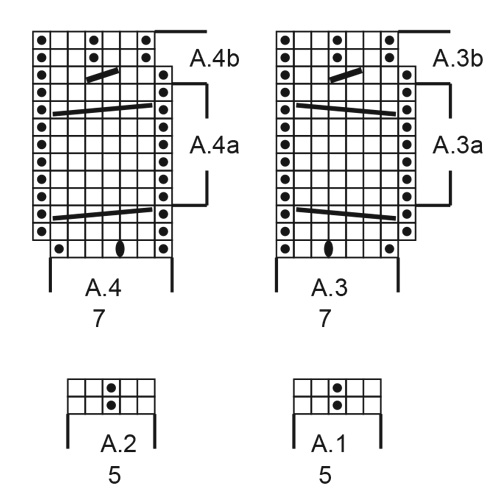
|
|||||||||||||||||||
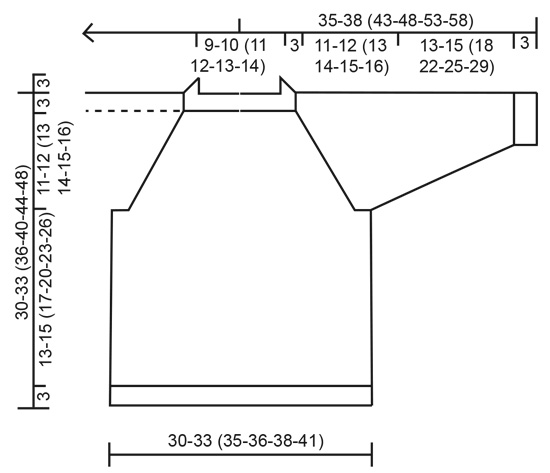
|
|||||||||||||||||||
|
Have you made this or any other of our designs? Tag your pictures in social media with #dropsdesign so we can see them! Do you need help with this pattern?You'll find tutorial videos, a Comments/Questions area and more by visiting the pattern on garnstudio.com. © 1982-2024 DROPS Design A/S. We reserve all rights. This document, including all its sub-sections, has copyrights. Read more about what you can do with our patterns at the bottom of each pattern on our site. |
|||||||||||||||||||







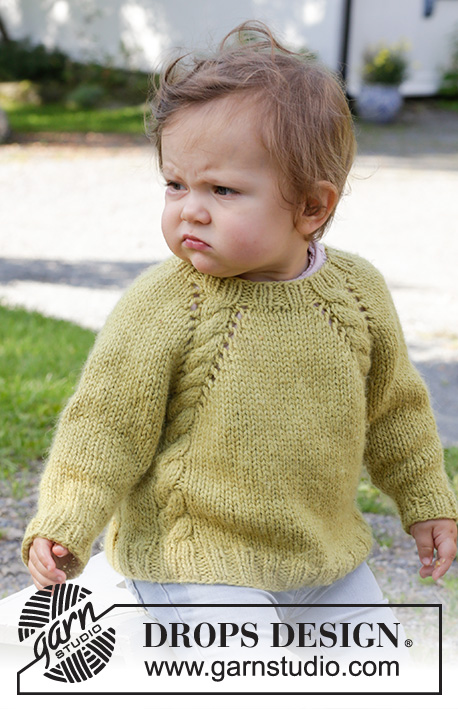
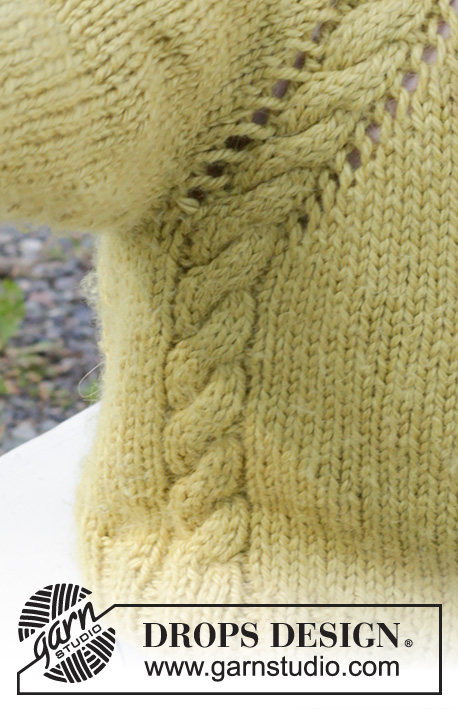

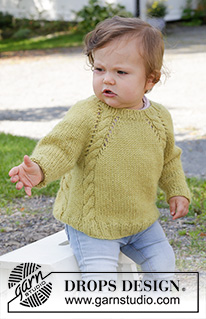

















































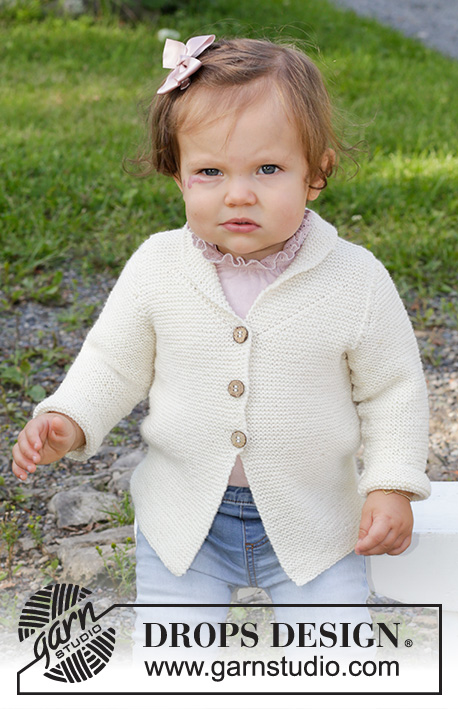






Comments / Questions (70)
Hallo liebes Drops Team, ich stricke die Größe 92-98 und verstehe bei der Passe nicht, wo die 4 zugenommenenen Maschen herkommen? Und wo/wie werden diese gestrickt? (....und 1 Masche in jedem A.3/A.4 zugenommen (= 4 Maschen zugenommen)) Für mich geht aus der Beschreibung hervor, dass ich 8 Umschläge und 8 Zunahmen habe = 16. Da würde ich auf 76 Maschen kommen und nicht auf 80.
15.12.2022 - 10:45DROPS Design answered:
Liebe Sonja, bei der Größe 92 (= 3. Größe; Größe 98/104 ist die 4. Größe) nehmen Sie einige Maschen regelmäßig verteilt bei der 1. Reihe der Passe zu, und zwar: 2 M über die ersten 3 M vom Rückenteil, 4 maschen über die 8 Maschen vom Vorderteil und 2 Maschen über die 5 Maschen von 2. Halb-Rücktenteil. Zusätlich nehmen Sie 8 Maschen für den Raglan zu - diese Zunahmen entstehen beidseitig von A.3 und A.4 (= 8 Zunahmen). Bei der 1. Reihe A.3 und A.4 nehmen Sie jeweils 1 Masche (4 zusätlichen Maschen bei dieser 1. Reihe zugenommen). Viel Spaß beim stricken!
15.12.2022 - 14:09Lurer på om diagragrammene til 3a og 4a er riktig, da blir det 6 rader med glattstrikk mellom flettene istedenfor 5 som det er i diagram 3 og 4
02.12.2022 - 10:08DROPS Design answered:
Hei Marie. Første gang når A.3a og A.4a strikkes det det 5 rader mellom flettene, men resten av flettene på genseren (når 3.A og 4.A strikkes) strikkes med 6 rader glattstrikk. mvh DROPS Design
05.12.2022 - 12:09Guten Tag, nochmals meine Frage: Ich stricke das Stück in der Größe 6/9. Nun eine Frage zu den Raglanzunahmen: Es ist angegeben, man soll A3 und A4 in der ganzen Höhe stricken und anschließend A3a und A4a wiederholen. So wird der Abstand zwischen 2. und 3. Zopf aber viel zu groß und die Maschenzahl stimmt auch nicht. Kann es sein, dass man von Anfang an nur bis zum Ende von A3a und A4a stricken soll, bevor man wiederholt? Vielen Dank.
19.11.2022 - 21:22DROPS Design answered:
Liebe Lisa, also bei A.3 und A.4 stricken Sie zuerst die 2 ersten Reihen (mit der Zunahme bei der 1. Reihe), dann stricken Sie und wiederholen Sie A.3a/A.4a, A.3b/A.4b stricken Sie erst später. Viel Spaß beim stricken!
21.11.2022 - 10:59Merci j'ai compris mon erreur de lecture du diagramme par le bas. :) J'ai bien mes 80 mailles, mais maintenant j'ai un nouveau problème. Il faut augmenter de 8 mailles tous les 2 rangs, il s'agit uniquement des jetés ? Car 80 + (11 x 8 jetés) = 168 mailles. On ne rajoute pas en plus 4 mailles pour le dos et 4 mailles pour le devant ? Sinon ça serait trop : 80 + (11 x 8 jetés) + (11 x (4m + 4m))
10.11.2022 - 11:21DROPS Design answered:
Bonjour Juju, effectivement les 4 augmentations des A.3 et A.4 ne se fait qu'une seule fois, vous augmentez ensuite seulement 8 mailles pour le raglan. soit 80 m + encore 11 fois 8 m = 80+88=168 mailles quand toutes les augmentations sont faites. Répétez les rangs des diagrammes A.3a et A.4a (la partie -b sera tricotée seulement en bas du pull, juste avant les côtes. Bon tricot!
10.11.2022 - 16:51Sur le premier tour de l\'empiecement, il n\'est pas écrit d\'augmenter dans A3 A4. Si je respecte ce qui est écrit, cela donne : 3 mailles +2 Aug +1 jeté +7 mailles A3 +1 jeté +8 mailles +1 jeté +7 mailles A4 +1 jeté +8 mailles +4 Aug +1 jeté +7 mailles A3 +1 jeté +8 mailles +1 jeté +7 mailles A3 +1 jeté +5 mailles +2 Aug = 76 mailles.
09.11.2022 - 17:15DROPS Design answered:
Bonjour Juju, les augmentations de A.3 et A.4 figurent dans les diagrammes - cf ovale noir = 3ème symbole de la légende, soit, je cite: faire 1 jeté entre 2 mailles, tricoter le jeté torse au tour suivant ainsi, vous avez 8 mailes pour tricoter A.3/A.3a et A.4/A.4a. Ce sont les 4 mailles qui vous manquaient. Bon tricot!
10.11.2022 - 10:52Bonjour, il y a un problème pour la taille 2 ans. Pour l'empiecement, lorsque l'on tricotéme les manches, ils disent d'augmenter de 0 mailles... Bizarre.. On devrait augmenter de 2 mailles pour chaque manche non ? Si on ne le fait pas, il manque 4 mailles. J'ai recalculé avec une calculatrice, on arrive bien à 76 si on augmente de 0, et pas 80.
09.11.2022 - 15:05DROPS Design answered:
Bonjour Juju, vérifiez bien votre nombre de mailles, tout doit tomber juste: vous aviez 60 mailles, vous augmentez 8 m à intervalles réguliers dos/devant + 4 m dans les diagrammes (1 dans chaque A.3/A.4) + 8 m pour le raglan, soit 60+8+4+8=80 mailles. Bon tricot!
09.11.2022 - 16:32Cześć, czytając wzór nie wiedziałam, o co chodzi z przerabianiem "ponad" oczkami - to błąd w tłumaczeniu, chodzi o "przez" daną ilość oczek. Może oszczędzę komuś kilka minut zastanawiania się :)
30.08.2022 - 21:36I am starting the yoke. I am confused about the instructions. there are 2 YO which would be two stitches increased but there is a note about increasing 2 stitches evenly. Are the YO's the stitches that are increased or am I to increase 2 more on top of those?
12.07.2022 - 03:09DROPS Design answered:
Hi Jennifer, The 2 YOs are increased evenly over the first 3 stitches and are the first increases for raglan. Then the other YOs are on each side of the sleeves or increased evenly over the knitted stitches on the front and back pieces. So no additional YOs. Happy knitting!
12.07.2022 - 06:57Sorry I'm none the wiser! My question was: Do I work all 13 rows of A.4 and then go back and keep repeating A.4a? My guess is that I just do the first 10 rows of A.4 before keep repeating A.4a. Please can you answer this question.
13.04.2022 - 19:53DROPS Design answered:
Dear Rachel, yes, you work the first 10 rows of A.4 and then keep repeating A.4a (you have worked A.4 1 time vertically and 1 repeat of A.4a). Happy knitting!
14.04.2022 - 17:23I am knitting the baby leaf sweater and am a bit puzzled as to A4 and A3. Do I do all 13 rows of the pattern of A.4 (including A.4b) at the beginning of the yoke and then go back and do A.4a.? Do I then keep repeating the A.4a section? Continental patterns are just so different from our English ones!!
12.04.2022 - 09:53DROPS Design answered:
Dear Rachel, A.3 and A.4 are the charts for the cables in the raglan lines. YOu work A.3 in the first raglan line (= back) and A.4 in the second one (= front). You work A.3 again in the 3rd raglan line (= front) and A.4 in the 4th raglan line, in the back. When you have repeated A.3/ A.4 once vertically, that is, you have worked all 4 rows of A.3/ A.4, start working A.3a over A.3 and A.4a over A.4. Happy knitting!
12.04.2022 - 18:13